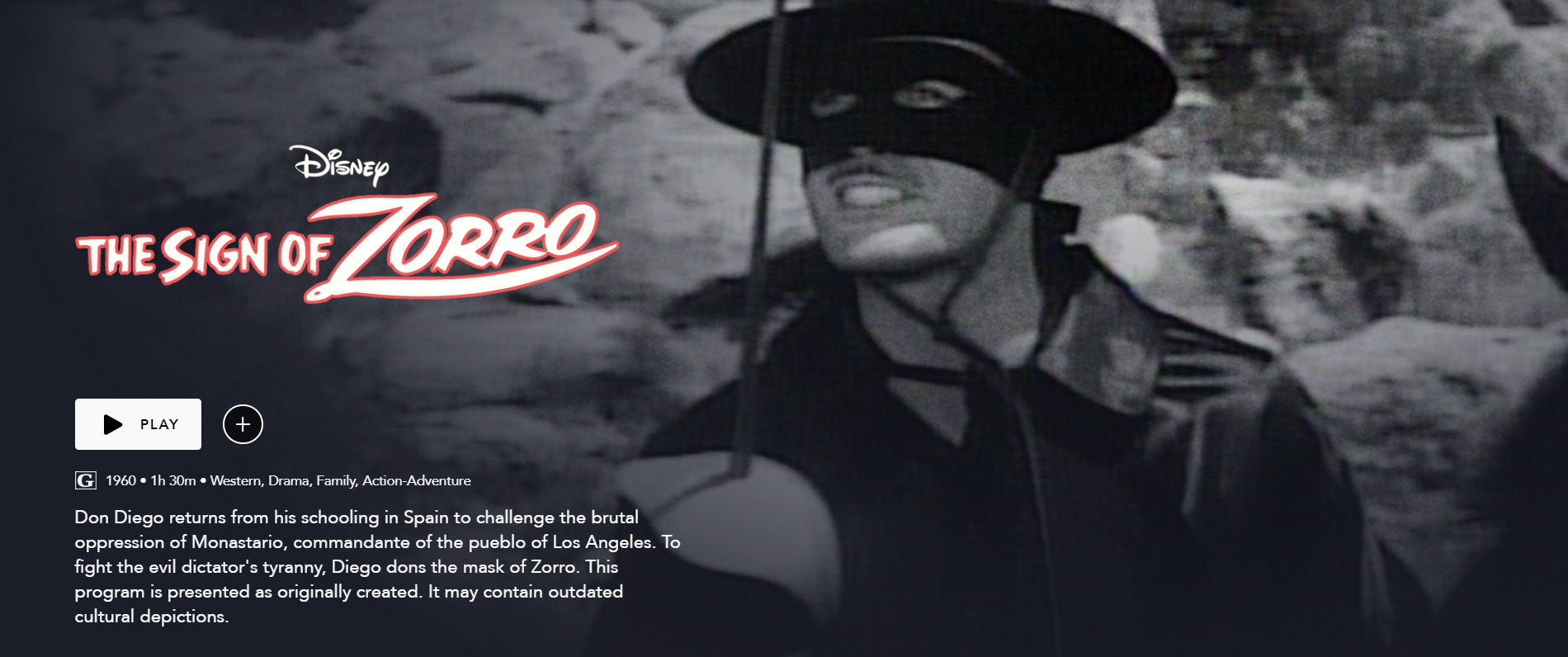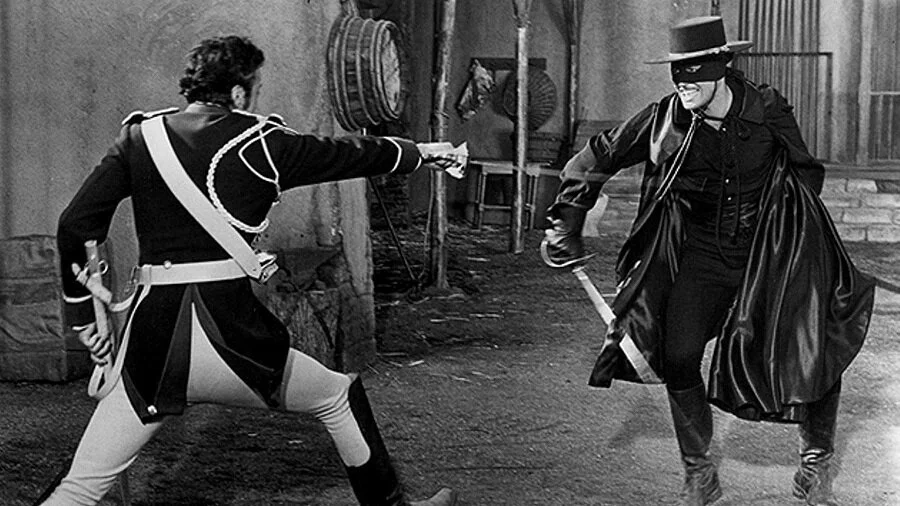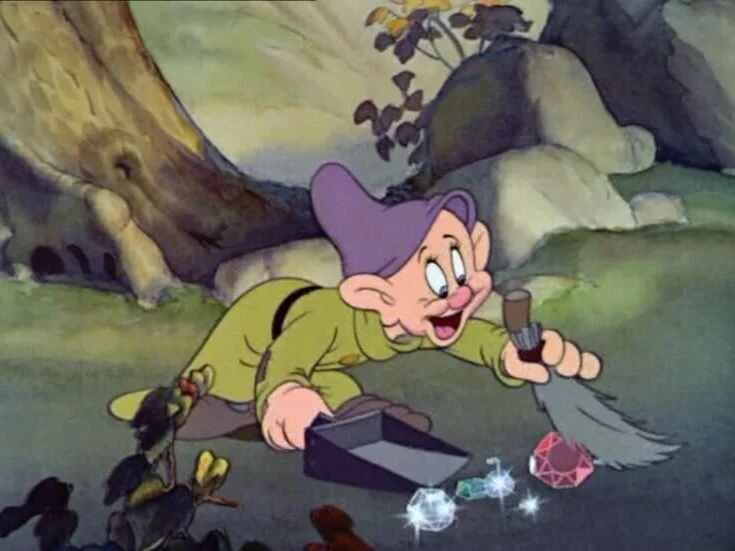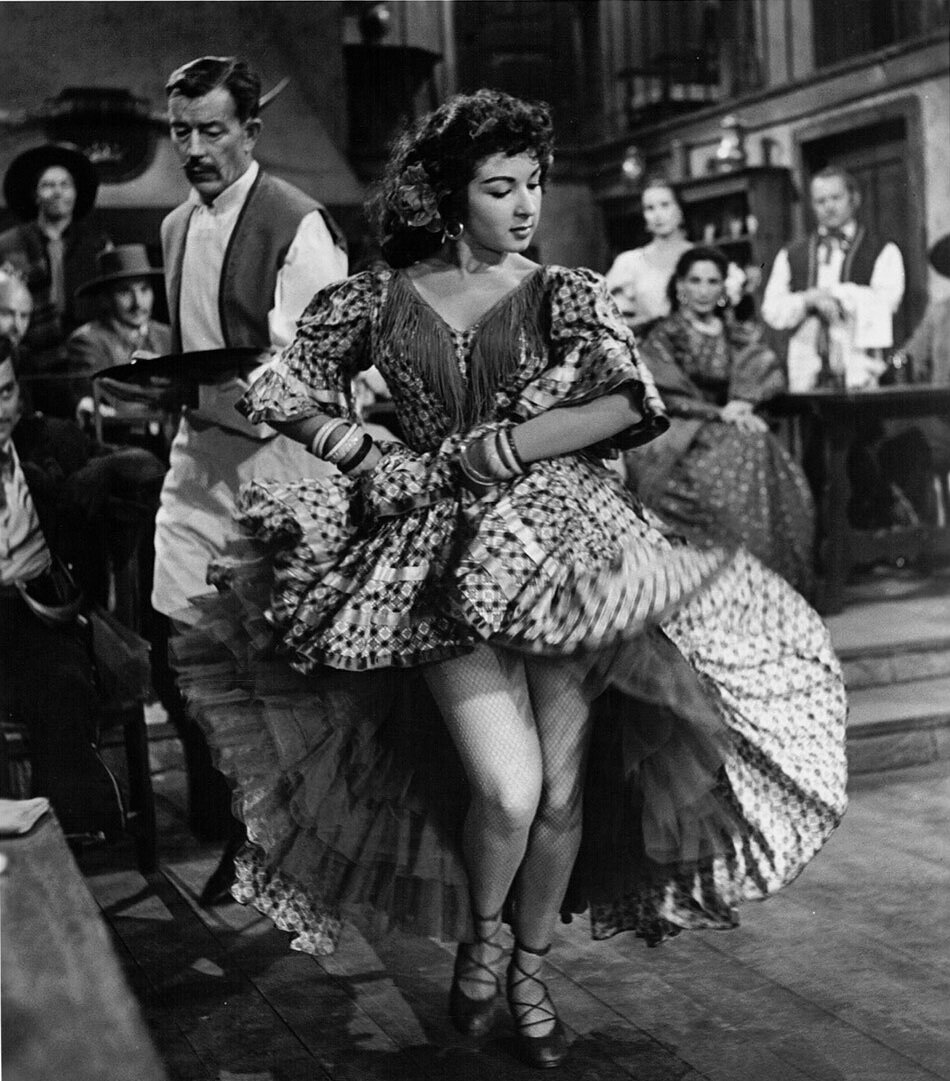Review: The Sign of Zorro (DMC #31)
“Out of the night, when the full moon is bright, comes the horseman known as Zorro!" This week we watched The Sign of Zorro, the 31st movie in our challenge. If you’ve been keeping up with us, feel free to scroll on down for the main review. If you’re new around here, check out our synopsis for a recap!
Synopsis
Don Diego de la Vega returns home to California after finishing his education in Spain. While on board a ship, he meets with his servant, the mute Bernardo. Bernardo gives Diego a letter his father, Alejandro, has written. A dictator has taken over the pueblo of Los Angeles, and the two decide they need to stop him. Bernardo suggests Diego pretend to be a scholar with no swordsmanship so as to throw everyone off the trail. They remove all traces of Diego’s fencing abilities, and Bernardo furthers the act by pretending to be both deaf and mute so he can act as Diego’s spy. They arrive in Los Angeles and meet Sergeant Garcia, a bumbling but kind-hearted man under the command of the pueblo’s new dictator, Captain Enrique Monastario. Diego spots a friend named Nacho Torres being taken away for acts of treason—speaking out against Monastario’s oppression. Diego meets briefly with Monastario, who is immediately suspicious of Diego. Diego returns home and greets his father, but while Alejandro is happy to have his son home, he requests his son help fight against Monastario. Diego keeps up his charade of the foppish scholar, which only frustrates his father and Diego himself. Diego instead decides to help his father and the people of Los Angeles as a masked vigilante: Zorro. That night, he and Bernardo learn that Torres is to be hanged, so Diego escapes the house through a secret cave. Meanwhile, Monastario sends his lackey Licenciado to Torres’ cell to tell him that he is to be set free. What Torres doesn’t know is that Licenciado will then sound the alarm of “prisoner’s escape” thus forcing Monastario to justify shooting him. Luckily, Zorro is able to stop this and frees Torres, escaping on his horse Tornado. Monastario puts a price out for Torres and Zorro, and arrests Torres’s wife and daughter as bait. Alejandro decides to rescue the women, but a servant of Monastario’s overhears the plot and warns the Comandante, who prepares an ambush for Alejandro. Alejandro is injured in the skirmish, and although Zorro arrives to help he eventually rescues his father. His father looks at the masked Zorro and expresses his regret that his son isn’t like this hero. Zorro, sadly, brings his father back to the Fox Hole to recuperate, but Alejandro leaves to find Monastario as soon as Zorro leaves. Zorro again arrives in time to save Alejandro from death when Monastario is about to kill him. On the way back to safety, Zorro and Alejandro come across Torres returning to Los Angeles with some soldiers as an escort and a promise of a fair trial.
Back at the pueblo, Torres and Alejandro are in jail awaiting trial, but are happily expecting the arrival of a fair judge. Monastario plots to prevent the judge from arriving. He has Licenciado fill in as the judge at the trial in order to get a guilty verdict unfairly. Garcia, unnerved by Monastario’s plan, tells Diego. Zorro arrives in the nick of time to force Licenciado to deliver “not guilty” by poking his sword into the man’s back. The two men are free to go. Later on at a bar, two men start a fight over a girl who is dancing. One of the men kills the other, and although he is brought to Monastario to face justice, Monastario instead offers the man, named Martinez, a deal: dress up as Zorro and rob the guests at an upcoming dinner party in order to discredit the vigilante. Martinez agrees. At the party, where Diego is a guest, the fake Zorro bursts in and robs everyone of their valuables. Diego manages to escape and suit up and get Bernardo on the scene as well. Garcia and Monastario mistake the real Zorro for Martinez, and Monastario “challenges” Zorro to a duel as a ploy to be the hero. Bernardo prevents Martinez from escaping the bar by moving the ladder he needs to climb down the building, and Martinez gives up. The two Zorros are now both in the bar, and Monastario realizes he was fighting the real one. Zorro defeats Martinez and unmasks him, and all the guests are relieved that their hero is not a thief. Diego plays up the act by having pretended to hide under a table. Bernardo brings news to Zorro that Martinez is dead, apparently having been shot while escaping jail. Diego easily figures out that Martinez is faking it as part of another plan by Monastario. Monastario rides out to a cave where Martinez is hiding and reveals the plan: fake Zorro will steal a valuable crown from a church. Although Martinez is aghast at the idea, he decides to go through with it. The pueblo learns of the heist and is once again doubting Zorro. Diego comes up with a counter-plan involving fake jewels.
Back at the bar, Diego slips some fake jewels and plants the idea that the crown thief is currently in town trying to dispose of the jewels. Licenciado, who was in on Monastario’s original plan, is also at the bar and is nervous that the plan has failed. He warns Monastario, who rides to the cave to kill Martinez, thinking him responsible. Martinez anticipates this and tricks Monastario. The two briefly duel, but Diego has followed. Diego decides to duel Martinez, continuing to act as if he’s completely unskilled even though he outclasses the stunned Martinez. Monastario shoots Martinez, killing him. Diego and Monastario question each other, and Monastario’s suspicion of Diego grows. Garcia later brings Diego in for questioning, where Monastario accuses Diego of being Zorro. Diego brushes this off while Garcia laughs, believing it to be completely impossible. They learn that the Viceroy is coming to visit the pueblo. Monastario panics and forces Garcia to empty the jail cells and make everyone appear cheerful even at the threat of being shot in order to convince the Viceroy that all is well. When the Viceroy arrives, he is immediately skeptical of the situation. He has heard of a masked outlaw, so he is curious about the lack of crime in the town. That night during dinner, Monastario tries unsuccessfully to convince the Viceroy that he has stamped out crimes, all while trying to flirt with the Viceroy’s daughter Constancia, who finds Monastario to be pompous and foolish. Monastario brings in Diego dressed like Zorro, claiming only a man of Diego’s build, height, and mustache could be Zorro. But the Viceroy and his daughter are old friends of Diego’s and do not believe it. Diego asks to have a private word with the Viceroy, and when Monastario returns, he again insists Diego is Zorro, until Diego pops up out from behind the bar. Licenciado is instead under the costume having been disguised. Monastario has had enough and challenges Diego to duel. Diego accepts, but continues to act foppish and unskilled, tricking Monastario into falling over and looking foolish. The Viceroy demands an end to the duel, but Monastario refuses. At that moment, another Zorro rides outside, throwing a dagger at the door. Attached is a note saying “Sorry to have missed your fiesta,” which convinces the Viceroy once and for all that Monastario is lying. The other Zorro is revealed to be Bernardo. Zorro’s identity remains safe and Monastario is arrested. Garcia is named his replacement, much to his happiness.
Thoughts Before Watching
Megan: I don’t think I ever saw the full movie, just the clips along with the theme song in Disney Sing-Along Songs: Heigh Ho. I know that as a kid I loved the theme song, and my siblings and I would pretend to slash a “Z” with our make-believe sword as we danced and sang along to it. While I thought Zorro was cool, I also thought he was a little bit scary—something about him wearing all black and the black-and-white filming made me think that maybe he was a bad guy instead of the hero. I’m curious to see the story behind those sing-along movie clips.
Kevin: I remember the theme song from the Disney Sing-Along Song films! Wow, this really brings back memories of those movies. I heard this was an edited compilation of episodes from the Disney television show, similar to the Davy Crockett films/series. I’ve never seen this particular film though, let alone the actual television series. My only exposure to any Zorro media is the film The Mask of Zorro, starring Antonio Banderas and Anthony Hopkins. I liked that film, so I’m curious if I’ll feel the same for this one.
Thoughts After Watching
The humor is great!
Megan: I found myself laughing out loud at several points throughout this film. What’s even better is that the humor was never at a character’s expense, but rather situational. I think Bernardo and Garcia are probably my favorite characters because they so often provide the comedic relief. I especially loved the scene where Garcia spots the real Zorro and, thinking him the fake Zorro, helps him sneak into Monastario’s party, while Bernardo keeps moving the ladder back and forth so the fake Zorro cannot escape.
Kevin: I love Garcia and Bernardo! They’re definitely the favorites here. Both actors, Henry Calvin and Gene Sheldon, respectively, were also in Babes in Toyland. In that movie, Calvin again played the role of bumbling but good-natured minion, and Sheldon was his sidekick of sorts, but their humor in both films is wonderful. Bernardo’s silent antics, such as him working out how to escape the cave, are hilarious. Garcia’s eagerness to please Monastario while also questioning his orders comes off funny, where perhaps in another movie it would be more a source of drama.
The action finally looks believable.
Kevin: One of the downsides of some of the previous live action films was the action, especially fight scenes (with the exception of The Story of Robin Hood). When you take a character like Zorro, well known for his swordsmanship, it seems like Disney made good calls with Guy Williams (Zorro) and Britt Lomond (Monastario), both of whom were professionally trained in fencing. Lomond even auditioned for the main role, but after Williams was chosen Lomond was cast in the role of the villain. This was a great choice, and the results were worth it as we finally get fight sequences that actually look great. In the back of my mind I realize they are highly choreographed, but it still felt as if the duelists were fighting for their lives (well, except maybe Zorro himself, who in most of his fights simply looks like he’s having the time of his life). The fights don’t just use swordplay, either; they also use tackles, shoves, kicks, and other methods. Property gets destroyed in these sequences—I mean, how many tables did Monastario destroy? I counted at least four (the guy’s got some impressive endurance, too. You’d think he’d be bed-ridden with pain after all that). The stunts are done well, too, and appear to have been done in single shots. Stunts of previous films would use multiple shots to create the effect, but The Sign of Zorro doesn’t have that feel. Lastly, I just want to compare the action sequences to those of another swashbuckler adventure: Treasure Island. One of my gripes with that film is that action sequences had no weight to them, not least because they weren’t that good to begin with, but because there was no heart or motivation behind them. With The Sign of Zorro, characters have clear reasons for why they are fighting, such as Zorro’s quest for justice and resistance to tyranny, or Monastario or Martinez’s desires for power, riches, or control. That last one isn’t admirable at all, but at least the motivation is there.
Mute Characters: Bernardo vs. Dopey
Megan: We don’t often see differently-abled characters in Disney films. In fact, as I was thinking back to all the films we’ve seen up to this point, we haven’t really seen any differently-abled characters since Dopey who weren’t pirates in Treasure Island or Peter Pan (unless you count Dumbo and his big ears). Pollyanna barely counts since her story is about her life before her injury, not after it. I think that’s why seeing Bernardo in The Sign of Zorro was so refreshing. Not only are we seeing a differently-abled character, but, unlike Dopey in Snow White and the Seven Dwarfs, Bernardo isn’t portrayed as stupid. Instead we see that Bernardo is respected by Diego, and he proves to be an invaluable partner in Diego’s plans, for it is Bernardo that suggests Diego pose as a scholar. What’s more, Bernardo uses his inability to speak to his advantage when he pretends to be both deaf and mute in order to spy on Monastario and his men (which, can I just say how impressive it is that he didn’t react to the gunshot and was able to maintain this facade?). While Bernardo’s character provides much of the humor in the film, we are not laughing at him or his muteness. Rather the humor is situational, often with Bernardo outsmarting the villains, as he does with the ladder and the fake Zorro. In contrast, much of Dopey’s humor relies on his stupidity, and he never makes any great contributions toward the dwarfs’ goals as more often than not he’s portrayed as a liability. Also, Dopey is unable to successfully communicate with the other dwarfs or Snow White, whereas Bernardo has no problem expressing himself through a version of sign language that Diego easily and fluidly understands. While it’s hard to say if any of the other characters in the film understand Bernardo’s sign language, we can assume those who have known him as long as Diego has are able to understand him. Oddly, in Dopey’s case, the dwarfs don’t always understand Dopey, though we assume they’ve lived and worked together most of their lives. I’m pretty sure the actor playing Bernardo was not actually mute in real life, so it still raises the issue of hiring able-bodied actors to portray differently-abled characters. However, I do appreciate that at least in this film the mute character isn’t just another Dopey.
Sucks to be a woman in this film…
Megan: I remember thinking several minutes into this film that we hadn’t seen a single woman yet, and then, as if hearing my complaint, we got women on screen—except they were prisoners. Yes, the first women we see in this film are Torres’s wife and daughter who are held hostage as bait for the return of Torres and for the masked Zorro. In this scene they are no more than human props since they barely speak and are simply pawns in Monastario’s plot. The next woman we see is Senorita Fuentes—a sexy dancer who quickly becomes the object of desire for every male character in the pub. This (predictably) leads to two men fighting over her, with Martinez ultimately killing his competitor, distressing Senorita Fuentes. Every time we see Senorita Fuentes again she is dancing as entertainment for a largely (or solely) male audience. Though she is a skilled dancer, the context of her performances makes me wonder, does she actually enjoy dancing for these men? Or is this the only way a woman can make any money in this male-dominated world?
Not even the Viceroy’s daughter, Constancia, is able to escape this trap—even with her family’s wealth and power—as she quickly becomes the object of Monastario’s highly unwanted desires. Monastario is so smitten with her that he even deludes himself into thinking Constancia likes him, too, when the reality is anything but. He asks Garcia for reassurance, and Garcia humorously replies that if he was a woman and as fat as he is he wouldn’t be particular about which man liked him. We laugh, but this implication perpetuates the unfortunate fat-shaming idea that women who are fat are undesireable, and thus lucky to have the attention of any man, regardless of whom she finds attractive. In this world, a woman’s worth is defined by her attractiveness and her ability to find a husband who can provide for her, since women cannot reliably earn an income for themselves. While Constancia would seem to have an edge over other women because men might want to marry her for her father’s money, it is her physical beauty that is Monastario’s focus. Thus, because it is the physical appearance of the female characters that is the focus of the male characters, we learn little to nothing about these women’s personalities or goals, which makes it hard to root for them.
This film also sadly fails the Bechdel test, since the only time two women speak to each other is when the women collecting the coins the men throw at Senorita Fuentes fight over the (fake) ruby Diego threw in hopes of revealing the crown thief. Not only are the women objectified and left to dance sensually in order to make money, they must compete with each other for that money (or in this case, jewels), too. Definitely not a world I’d want to live in as a woman.
The villain’s defeat is non-violent.
Kevin: Many Disney films within this genre or similar genres have gruesome defeats for their villains. Even the last swashbuckler film was a bit graphic with its depiction of the Sheriff of Nottingham being crushed to death. Here, however, Monastario is defeated because Diego outsmarts him. At the very beginning of the film, Diego says the best way to deal with a tyrant the likes of Monastario is to “convince him that [Diego] is perfectly harmless” rather than the more direct approach by defeating him in a duel. This is exactly what happens in the end; although Diego does defeat his enemy in several duels, Monastario’s true defeat comes when Diego convinces everyone in the pueblo that he can’t possibly be the masked Zorro. Of course Monastario is completely right, but he’s the bad guy with some truly evil intentions. His actions are revealed to the Viceroy, who is so irritated at Monastario’s constant insistence of Diego’s alter ego in spite of the “evidence” that the Viceroy places Monastario under arrest, leaving the pueblo under the command of Garcia. This is quite different from the ending of The Mask of Zorro, which is interesting to me since they use the same character and lore. In The Sign of Zorro, however, Diego could have easily taken out the brutal dictator, but chose to essentially humiliate and replace him instead. Honestly, it’s a better take and better lesson, and it works better in this story than it probably would in others. Not all villains have to be killed to be defeated.
Honestly, the villains are pretty freakin’ evil.
Kevin: Monastario isn’t a planet-destroying supervillain, but he’s still got some very terrible qualities. He has no qualms whatsoever about hurting the people he is supposed to govern, not just because he’s out for personal gain, but simply because he enjoys it. Monastario purposely withholds a fair trial for Torres and Alejandro because he wants them dead. He allows Martinez to harm civilians just so he can ruin Zorro’s reputation. He has no compunction about tricking an innocent man into going free just so he can justify shooting him later. He brags of his oh-so-great leadership and calls BS on all news against him (sounds eerily familiar these days…). He’s the bully who pushes people around because he knows he can get away with it. But Monastario has political power, so it’s even worse. Martinez is another villain, although secondary, with a lot of ugly traits. He practically oozes with glee at the thought of killing someone, yet is horrified at the idea of stealing from a church (though he gives in anyway). Both of these men are just a bit too comic-book villain-y; I mean, yes, they are literal comic book villains, but I mean in the way they’re one-dimensional and not very nuanced. This is just a small criticism I have about the film/series. Other than this though, I have to say that Monastario is kind of entertaining to watch, if only for the moments he’s outwitted.
I wish Alejandro had learned Zorro’s identity.
Kevin: Okay, I have one more criticism, but it’s short. I really wish the cut of the theatrical film showed Alejandro learning that his son was Zorro, as I think it would have provided closure to a story arc that was established earlier on. As I understand it, the theatrical film is cut from the show’s first season, but Alejandro didn’t learn of Diego’s alter ago until season 2. I imagine that the two finally understood one another and Alejandro admitted that he was proud of his son. I suppose it’s not totally necessary to conclude this plot, since the idea was to preserve Diego’s secret in order to oust Monastario and save the pueblo, but when viewed only in the context of the theatrical cut, I think Diego sorely wanted his father’s approval. Dropping this plot line is just a minor shame. Other than that, though, I really do enjoy how this film ended. I really should look into whether I can find the whole television series—which is not currently on Disney+, funnily enough.
Verdict
Kevin: 7
Megan: 6
Final Score: 6.5
Did you enjoy The Sign of Zorro? How do you think it compares to more recent adaptations? Please share with us in the comments!





